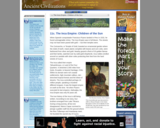
very useful to understand liquid
- Subject:
- Applied Science
- Material Type:
- Reading
- Author:
- Kevin Maximo
- Matheo Ryan
- May Ann Antiquisa
- Date Added:
- 03/26/2020

very useful to understand liquid

In this activity, students determine their own eyesight and calculate what a good average eyesight value for the class would be. Students learn about technologies to enhance eyesight and how engineers play an important role in the development of these technologies.

Students may recognize the importance of their senses, but they don't often focus on them individually. Students will experiment with sounds made by leaves, feeling different textures, observing different colors, and much more.

Esta es una lección para el aprendizaje a distancia que los alumnos pueden completar en casa.Los estudiantes evaluarán el impacto del lenguaje sensorial y el lenguaje figurativo en la poesía, y determinarán el significado general del poema utilizando el espacio al aire libre como contexto para la escritura.Esta actividad fue creada por Out Teach (out-teach.org), una organización sin fines de lucro que proporciona aprendizaje experiencial al aire libre, con el objetivo de transformar la educación de las ciencias para los estudiantes en comunidades más desatendidas.

Esta es una lección para el aprendizaje a distancia que los alumnos pueden completar en casa.Los estudiantes explorarán al aire libre en busca de ejemplos de transferencia de calor a través de la conducción, la convección y la radiación.Esta actividad fue creada por Out Teach (out-teach.org), una organización sin fines de lucro que proporciona aprendizaje experiencial al aire libre, con el objetivo de transformar la educación de las ciencias para los estudiantes en comunidades más desatendidas.

Students practice using articles by rewriting sentences using a or an. This is activity 1 of 2 in the series.

Students practice using articles by rewriting sentences using a or an. This is activity 2 of 2 in the series.

Students practice using articles by filling in the blank with a, an, or the.

Student groups create working radios by soldering circuit components supplied from AM radio kits. By carrying out this activity in conjunction with its associated lesson concerning circuits and how AM radios work, students are able to identify each circuit component they are soldering, as well as how their placement causes the radio to work. Besides reinforcing lesson concepts, students also learn how to solder, which is an activity that many engineers perform regularly giving students a chance to be able to engage in a real-life engineering activity.

Students explore human nature through careful study of the Russian Revolution, focusing on the ways in which leaders manipulated and oppressed their own people.

Students conduct a simple experiment to model and explore the harmful effects of acid rain (vinegar) on living (green leaf and eggshell) and non-living (paper clip) objects.

Students construct rockets from balloons propelled along a guide string. They use this model to learn about Newton's three laws of motion, examining the effect of different forces on the motion of the rocket.

Students will use knowledge of adaptations to compare the structures and functions of plants. These likenesses are passed down between parent plants and their offspring

Students explore the attributes necessary for survival and the importance of physical and mental strength by reading excerpts from Julie of the Wolves, Endangered, Hatchet, and a variety of poems.

In this lesson, students will develop their fluency with addition and subtraction through a "real-world" application of collecting data about insects in the garden.

In this lesson, students will develop their fluency with addition and subtraction through a real world application of collection data.

Students will use objects found in the outdoor classroom to create rectangular arrays and write equations to express the total. Standard(s): 2.NC.OA.4Use addition to find the total number of objects arranged in rectangular arrays with up to 5 rows and up to 5 columns; write an equation to express

Students practice writing with adjectives, adverbs, and prepositional phrases by combining three or four sentences. This is activity 1 of 2 in this series.

Students practice writing with adjectives, adverbs, and prepositional phrases by combining three or four sentences. This is activity 2 of 2 in this series.

Students practice writing sentences with both adjectives and adverbs by combining three sentences.